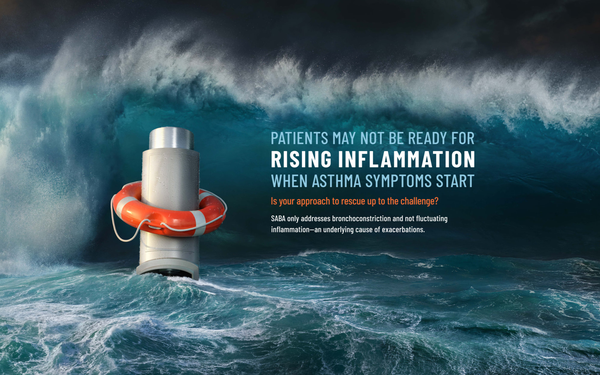
According
to AstraZeneca research, less than 30% of America’s 25 million+ asthma sufferers are aware that their rescue inhaler (e.g., albuterol) does nothing against airway inflammation, which usually
gets treated via such long-term inhalation maintenance therapies as GSK’s Flovent and Advair.
“Albuterol alone addresses airway tightening but doesn’t address the underlying
inflammation that contributes to the acute or sudden symptoms like coughing, chest tightness and shortness of breath,” Nicole Skiljo, AstraZeneca’s executive director for U.S.
marketing, tells Marketing Daily.
What’s needed, according to recently revised guidelines from GINA (Global initiative for Asthma), is “a rescue approach that treats both
symptoms and inflammation at the same time,” Skiljo says.
advertisement
advertisement
Such a drug is not currently available in the U.S., although AstraZeneca in January received FDA approval for
one, called AirSupra.
No specific medication, however, is associated with two recently launched unbranded AstraZeneca educational campaigns created by WPP’s VMLY&R:
“2 Sides 2 Asthma,” directed at consumers, and “Rescue Rescue” for healthcare providers (HCPs).
Each distinct campaign is designed to educate its
target audience about the role of airway inflammation in asthma attacks.
“2 Sides 2 Asthma,” which Skiljo says will reach nearly 3 million asthma sufferers this year, uses paid ads
to drive consumers to a website of the same name. One ad pictures a patient with her respiratory system looking like a twisting drinking straw and the copy, “Airway tightening in asthma can feel
like you’re breathing through a straw. But did you know inflammation is an underlying cause of your symptoms? There are 2 sides to an asthma attack but your rescue inhaler only treats
one.”
The consumer site’s many features include AIRQ (Asthma Impairment and Risk Questionnaire), described as
“a set of 10 yes-or-no questions designed to help you and your doctor better understand your current level of asthma control.”
“Rescue Rescue,” which
Skiljo says will reach more than 150,000 pulmonologists, allergists and primary care physicians this year, uses paid ads to drive the audience to risinginflammation.com. One ad pictures a rescue
inhaler adrift in a life preserver with copy reading, “Patients may not be ready for rising inflammation when asthma symptoms start.’
The HCP site’s many
features include an interactive tool for HCPs to learn more about asthma exacerbation by location.
The paid ads are running on video, display, social, audio, print and
digital out-of-home media.
“The reason these campaigns are really important to the asthma community,” Skiljo says, “is that asthma patients continue to be at risk of
exacerbation, regardless of their level of albuterol use, no matter how adherent they are to their maintenance background, and no matter their disease severity.
“Addressing fluctuating
inflammation with rescue threrapy at the time of an attack is very different than what we’ve seen before,” she continues. “With the campaigns, we’re empowering HCPs and
patients to demand more from their rescue therapy -- to address both sides of an asthma attack.”
AstraZeneca will measure “patient understanding of our key messages,” Skiljo
says, “and engagement across our websites, web visits, resource downloads, click-throughs, video completions, and email signups.”
Both AstraZeneca educational
campaigns will run at least through the end of the year, she says.
AirSupra will reportedly be available in the first quarter of 2024.